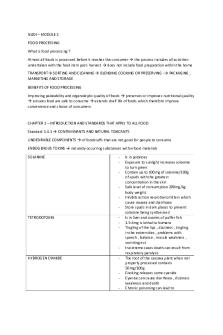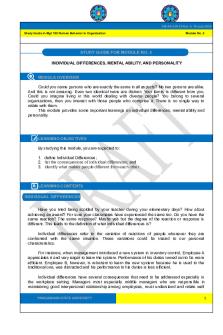ACC 500 Module 2 Lecture PDF

| Title | ACC 500 Module 2 Lecture |
|---|---|
| Author | Michael Morales |
| Course | Managerial Accounting |
| Institution | Southern New Hampshire University |
| Pages | 5 |
| File Size | 251.5 KB |
| File Type | |
| Total Downloads | 82 |
| Total Views | 160 |
Summary
Download ACC 500 Module 2 Lecture PDF
Description
Financial Statement Analysis Tools and Techniques Financial performance evaluation or financial statement analysis are techniques users of financial information employ to show important relationships in an organization‘s financial statements and to relate those relationships to important financial objectives. Management sets the financial performance objectives related to liquidity, profitability, long term solvency, cash flow adequacy, and market strength. Some financial performance objectives may be required by covenants tied to loan agreements or required to maintain favorable interest rates on revolving lines of credit. In addition, some of these performance objectives such as forecasted growth, earnings per share, and stock price may be shared with the investing community. If these targets are not achieved, financial investors and other external users may lose confidence in the performance of the firm and its management. Financial data for analysis, as well as prepared company analysis, can be found in a variety of published and online sources. A list of common resources includes: • • • • •
Reports published by the company Interviews given by corporate executives (audio and video) to the investment community SEC Reports Business Periodicals Credit and Investment Advisory Services (e.g., Value Line, Morningstar, Mergent Online, Hoovers, Standard and Poor’s, Dun & Bradstreet [D&B], Bloomberg’s, and commercial investment and banking firms such as Smith Barney, Morgan Stanley, etc.)
Some of these resources would provide financial statements for analysis; others will provide an analysis from existing financial data. Some common analytical techniques include horizontal, vertical, and ratio analysis.
ACC 500 Module Two
1
Horizontal analysis or comparative analysis can be used to compare changes in performance from one year to the next for each account. Each account should show the change from year 1 to year 2 (for example: 2006 to 2007) and then determine what percentage that change represents. This is accomplished by dividing the amount of the change by the amount in the first year (2006). Note that information is being compared “across” the same account or title; therefore, it is horizontal analysis. Look at this Excel file for the video gaming company Gamestop to see how horizontal analysis would look for a balance sheet, income statement, and statement of cash flows. Trend analysis is another form of horizontal analysis. The goal in this case, however, is not to calculate a value and percentage change but instead show trends of a particular account over time. This is accomplished by first selecting a “base year” (generally the earliest year in the analysis) and then computing the percentage of each subsequent year in relation to the base year. An example of trend analysis for Gamestop can be viewed in this Excel file. Vertical analysis or common size financial statements simply reform each financial statement into a “percentage of the whole” rather than a specific monetary value. This technique is particularly useful for evaluating the relative profitability of a company, as well as management’s ability to control various expenses. It is also useful to determine if any specific account categories have changed significantly and unfavorably on the balance sheet. In the case of the balance sheet, each account is restated as a percentage of total assets. In the case of the income statement, each account is restated as a percentage of net sales. An example of common size statements for BJ’s Wholesale Club can be seen here. Gamestop’s common size statements are presented here. Ratio analysis is used to express meaningful relationships among components of financial statements. Such a study must consider analysis of the underlying data. The primary purpose of ratios is to point out company situations that may need further analysis and corrective actions. Ratios by Category The classification of ratios and formulas in the linked document above are typical of ratio analysis processes but are not the only formulas, ratios, or categories used for such classification (Horngren, Sundem, Stratton, Schatzberg, 2011). Similar ratios and classifications can be found by looking at D&B Key Business Ratios online in the Shapiro Library or by going to one of the following websites: • •
2
Reuters Yahoo Finance
ACC 500 Module Two
Assessing the Financial Health and Outlook for a Company Earlier, students applied a series of financial analysis tools and techniques to raw financial data. But what does this data mean and how can it best be interpreted? In the conceptual framework established earlier, there were two secondary qualitative characteristics of financial information: first, that the information is consistent; and second, that the information is comparable. Consistency requires a company to use the same accounting policies over time, allowing investors to compare one year’s performance with the next year's (this is known as intra-company comparison). Comparability is an expectation that a company is using the same reporting standards as other companies in its industry. This would allow investors and creditors to compare the performance of one company to another in the same industry. Ratios vary greatly from one industry to another. Return on assets will be very different for an auto manufacturer as compared to a software manufacturer. Ratio analysis is most effective when analysts conduct both an intra-company and inter-company comparison with others in the same industry. A very important analytic technique used to better evaluate ROE is referred to as the DuPont Analysis. In the DuPont analysis, a company’s ROE is disaggregated into its three components (Easton, Halsey, McAnally, Hartgraves, & Morse, 2010). This process is presented below. DuPont Analysis ROE is a function of three factors: profitability, efficiency, and leverage. ROE is computed by dividing net income by equity. When disaggregated, ROE is calculated by the following: ROE = Return on Sales x Asset Turnover x Equity Multiplier (Profit Margin) (Asset/Equity Ratio) = Net Income x Net Sales x Net Sales Average Assets
Assets Equity
A favorable ROE as a result of higher profits and better asset turnover is better than a favorable ROE as a result of high leverage as measured by the equity multiplier. When looking at ROE, it is important to look at the causes for favorable versus unfavorable performance. It is important to look at industry trends, to compare the company to others in the industry and to look at major changes in the company or industry that could have precipitated changes in performance. This is where the additional information found in a company’s 10K is very important. As an example, please click on the following link to view the 10-K for Colgate-Palmolive.
ACC 500 Module Two
3
Financial statements make up less than five pages of this eighty page 10-K report. Important information is presented in the business section that discusses risk factors inherent in the industry and with the company. The section entitled "Management's Discussion and Analysis of Financial Condition and Results of Operations" presents specific reasons why various balance sheet and income statement accounts may have changed significantly due to acquisitions, divestitures, market development initiatives, increases in raw materials and transportation costs, labor disputes, lawsuits, etc. One of the best sources of additional information is provided in the notes to financial statements that run from page 42 to page 73 for Colgate.
4
ACC 500 Module Two
References Easton, P. D., Halsey, R. F., McAnally, M. L., Hartgraves, A., & Morse, W. J. (2010). Financial & managerial accounting for MBAs (2nd ed.) Cambridge, MA: Cambridge Business Publishers. Horngren, C. T., Sundem, G. L., Stratton, W. O., & Schatzberg, J. O. (2011). Introduction to management accounting (15th ed.). NJ: Pearson Hall.
ACC 500 Module Two
5...
Similar Free PDFs

ACC 500 Module 2 Lecture
- 5 Pages

ACC 500 Module 8 Lecture
- 4 Pages

HIM- 500 Module 4 Activity
- 4 Pages

HIM 500- Module 7 Activity
- 4 Pages

ACC 202 problem set module 2
- 1 Pages

ACC 202 problem set module 2
- 2 Pages

ACC 202 problem set module 2
- 1 Pages

Module 2- Lecture Notes
- 1 Pages

Module 2 - lecture
- 6 Pages

Module 2 - Lecture notes 2
- 4 Pages

Module 5 - Lecture notes 2
- 1 Pages

Module 5 - Lecture notes 2
- 67 Pages

2 Basco Type 500 (Multitubular)
- 12 Pages

Module 2 Draft - Lecture notes 2
- 15 Pages
Popular Institutions
- Tinajero National High School - Annex
- Politeknik Caltex Riau
- Yokohama City University
- SGT University
- University of Al-Qadisiyah
- Divine Word College of Vigan
- Techniek College Rotterdam
- Universidade de Santiago
- Universiti Teknologi MARA Cawangan Johor Kampus Pasir Gudang
- Poltekkes Kemenkes Yogyakarta
- Baguio City National High School
- Colegio san marcos
- preparatoria uno
- Centro de Bachillerato Tecnológico Industrial y de Servicios No. 107
- Dalian Maritime University
- Quang Trung Secondary School
- Colegio Tecnológico en Informática
- Corporación Regional de Educación Superior
- Grupo CEDVA
- Dar Al Uloom University
- Centro de Estudios Preuniversitarios de la Universidad Nacional de Ingeniería
- 上智大学
- Aakash International School, Nuna Majara
- San Felipe Neri Catholic School
- Kang Chiao International School - New Taipei City
- Misamis Occidental National High School
- Institución Educativa Escuela Normal Juan Ladrilleros
- Kolehiyo ng Pantukan
- Batanes State College
- Instituto Continental
- Sekolah Menengah Kejuruan Kesehatan Kaltara (Tarakan)
- Colegio de La Inmaculada Concepcion - Cebu

